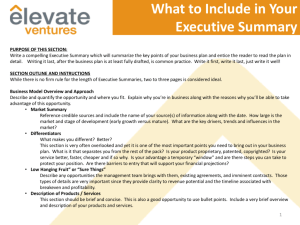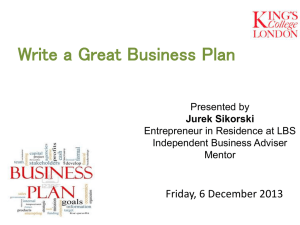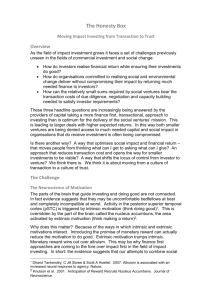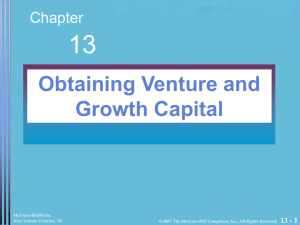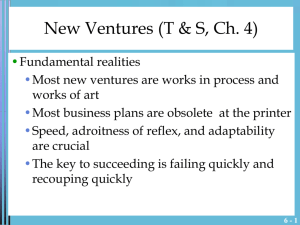Lecture 10
advertisement
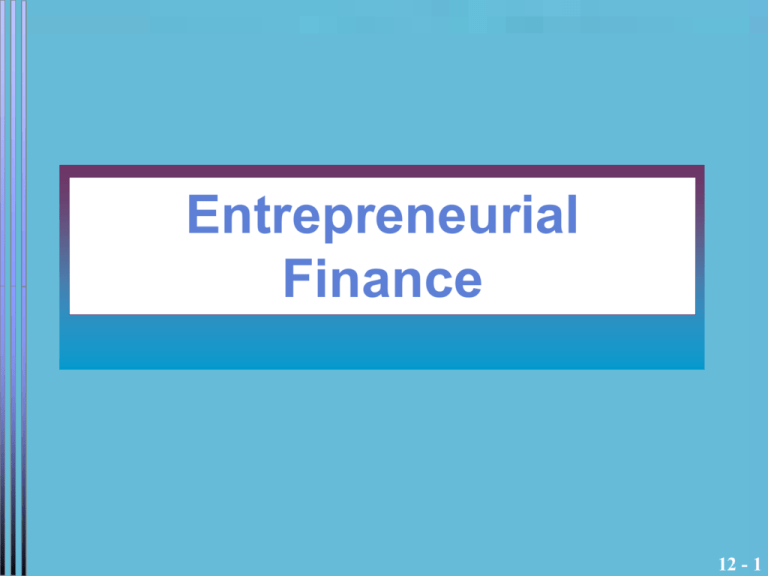
Entrepreneurial Finance 12 - 1 Entrepreneurial Finance • Three core principles of entrepreneurial finance • More cash is preferred to less cash • Cash sooner is preferred to cash later • Less risky cash is preferred to more risky cash 12 - 2 Exhibit 12.3 12 - 3 Exhibit 12.4 12 - 4 Bargaining Power • Three vital corollaries determining bargaining power • Burn rate • Time to OOC (Out Of Cash) • TTC (Time To Close) 12 - 5 Free Cash Flow • The cash flow generated by a company or project is defined as follows: • Earnings before interest and taxes (EBIT) • Less tax exposure (tax rate times EBIT) • Plus depreciations, amortization, and other non-cash charges • Less increase in operating working capital • Less capital expenditures 12 - 6 Operating Working Capital • Operating working capital can be defined as follows: • • • • • • • Transactions cash balances Plus accounts receivable Plus inventory Plus other operating current assets Less accounts payable Less taxes payable Less other operating current liabilities 12 - 7 Factors Affecting Financing • Accomplishments and performance to date • Investor’s perceived risk • Industry and technology • Venture upside potential and anticipated exit timing • Venture anticipated growth rate • Venture age and stage of development 12 - 8 Factors Affecting Finance • Investor’s required rate of return or internal rate of return • Amount of capital required and prior valuations of the venture • Founders’ goals regarding growth, control, liquidity, and harvesting • Relative bargaining positions • Investor’s required terms and covenants 12 - 9 Exhibit 12.6 12 - 10 Obtaining Risk Capital • Three central issues to be considered • Does the venture need outside equity capital? • Do the founders want outside equity capital? • Who should invest? 12 - 11 Angel Investors • Who are angel investors? • • • • Most are self-made entrepreneur millionaires Many are in their 40s and 50s Most are well educated Ninety-five percent have college degrees from four-year colleges • Fifty-one percent have graduate degrees (Forty-four percent are in a technical field and thirty-percent percent are in business or economics) • Ninety-six percent are men 12 - 12 Informal Investors • What type of ventures lends themselves to the use of informal investors? • Ventures with capital requirements of between $50,000 and $500,000 • Ventures with sales potential of between $2 million and $20 million within 5 to 10 years • Small, established, privately held ventures with sales and profit growth of 10% to 20% per year 12 - 13 Informal Investors • What type of ventures lends themselves to the use of informal investors? • Special situations, such as very early financing of hightechnology inventors who have not developed a prototype • Companies that project high levels of free cash flow within three to five years 12 - 14 The Classic Superdeal 12 - 15 What to Look for in Investors • Seek investors who: • Are considering new financing proposals and can provide the required level of capital • Are interested in companies at the particular stage of growth • Understand and have a preference for investments in the particular industry 12 - 16 What to Look for in Investors • Seek investors who: • Can provide good business advice, moral support, and has contacts in the business and financial community • Are reputable, fair, and ethical and with whom the entrepreneur gets along • Have successful track records of 10 years or more advising and building smaller companies 12 - 17 What to Look Out for in Investors • Attitude • Be wary if getting through to a general partner in the investment firm is an ordeal • Be wary if the investor thinks he or she can run the business better than the lead entrepreneur or the management team • Over commitment • Be wary of lead investors who indicate they will be active directors but who also sit on the boards of six to eight other startup and early-stage companies or are in the midst of raising money for a new fund 12 - 18 What to Look Out for in Investors • Inexperience • Be wary of dealing with venture capitalists who are under 30 years of age and have: • An MBA • Only worked on Wall Street or as a consultant • No operating, hands-on experience in new and growing companies • A predominantly financial focus 12 - 19 What to Look Out for in Investors • Unfavorable reputation • Be wary of funds that have a reputation for early and frequent replacement of the founders • Be wary of those where more than one-fourth or the portfolio companies are in trouble or failing to meet projections in their business plans • Predatory pricing • Be wary of investors who unduly exploit conditions during adverse capital markets by forcing large share price decreases in the new firms and punishing terms on prior investors 12 - 20 Presenting Information to Possible Investors • A concise presentation should include the following: • • • • • What is the market opportunity? Why is it compelling? How will/does the business make money? Why is this the right team at the right time? How does an investor exit the investment? 12 - 21 How VCs evaluate opportunities • Siegelman, KPCB • Big markets, competitive edge, great team • Technical due diligence is big, some customer and industry diligence, background checks on team • $500K smallest investment, $3-$5m to $10m, • FAST deals – a week or two • Don’t invest in low price products without a low price channel, $200K price tag for enterprise software • 50% gross margin on hardware • Looking for IPO 12 - 22 Wang, Trinity Ventures • Team, market opportunity, value proposition/product • Focus on the CEO • It’s a sector bet – thesis process every quarter • • • • • Everything looks like its going to be a multi-billion dollar market We avoid arm-wrestling with ‘wild eyed technologists’ Focus on smaller opportunities with less uncertainty 18 month window, Series A Lot of time on financial model – bottom up 12 - 23 Simon, Alta Partners • I think markets trump people and technology • I look for big opportunities, big painful problems that customers have • We don’t target market shares, we target revenue $60-$80m in 3 years • Ideal case – four PhDs solve a problem after a year or two and it’s 2 orders of magnitude better than whatever else is out there • Lot of focus on personal motivations of people • are they in it for the long haul (with passion) • Need to “monetize” customers (e.g. Skype) • One or two “brave new world” investments • • • • Bet on marketing or technology side 1-6 month decision frame Exit at $200m market and $60-$80m company size Advise clients to not dilute a good business which won’t grow to that size (and thus is not a good venture opportunity) • Check out Sand Hill Road, Menlo Park, CA 12 - 24 Value-added of smart investors • Fund-raising know-how and contacts • Recruiting • Industry contacts and networking • potential strategic partners and customers • Unbeatable market intelligence • Technological know-how • Ability to redirect the team or refocus the business • A vested interest in the startup’s success 12 - 25 Case • Walnut Associates (A) 12 - 26

